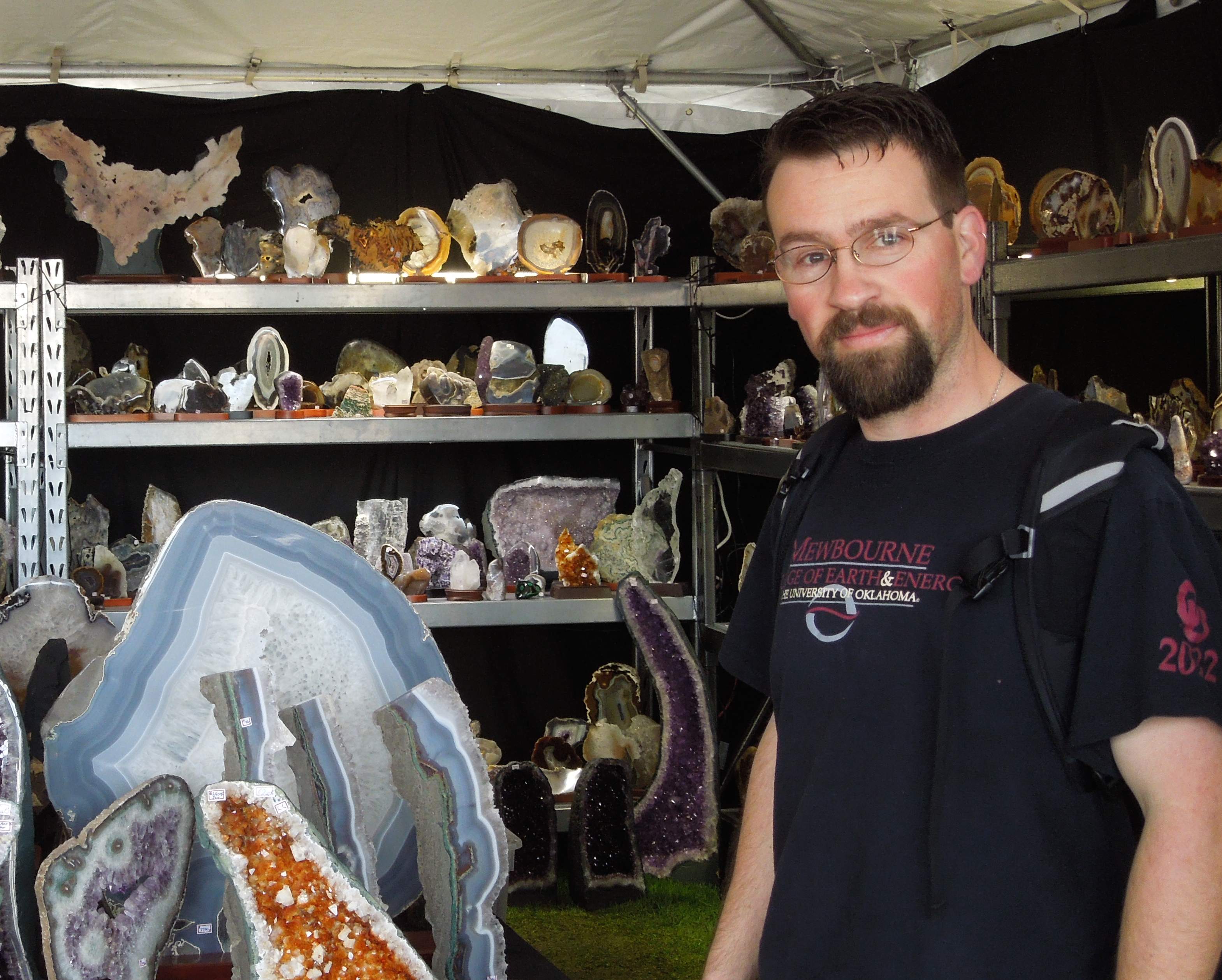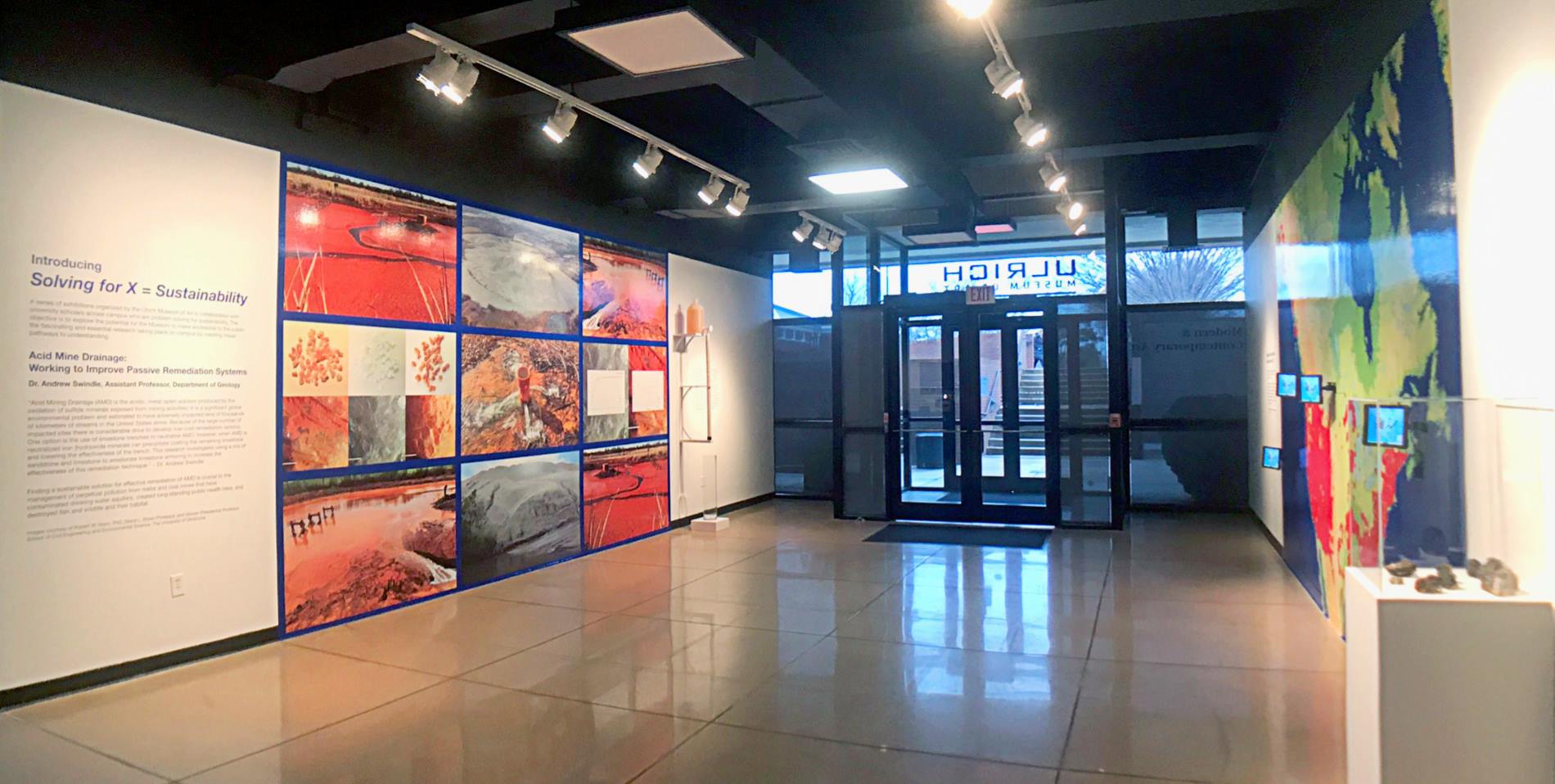 Andrew Swindle
Andrew Swindle
Associate Professor
Graduate Program Coordinator
Room: GE 007A
Email: andrew.swindle@wichita.edu
Phone: 316-978-7211
| Academic Credentials: | Professional Experience: |
|
Ph.D., 2013, University of Oklahoma M.S., 2003, Oklahoma State University B.S., 1999, Oklahoma State University |
- Wichita State University – Assistant Professor (2014-2020) – Associate Professor
(2020-present) - University of Oklahoma – Postdoctoral Research Associate (2013-2014) - University of Oklahoma – Teaching and Research Assistant (2009-2013) - URS – Staff Hydrogeologist (2008-2009) - Weaver Boos Consultants – Staff Geologist (2005-2008) - SCS Engineers – Staff Geologist (2004-2005) - Secor International – Staff Technician (2004) |
Research Areas
My main research area focuses on the reactivity of nanoscale materials in the subsurface.
Nanoscale minerals are ubiquitous in the environment and play major roles in the chemistry
that happens in the soils, sediments, and rocks near the Earth’s surface. Broadly
speaking, I am interested in how the combination of nanoparticles and geochemistry
can contribute to the transport of a contaminant in the environment. I also approach
the issue from the other side and investigate the fate of anthropogenic nanomaterials
in the environment. Some of my other research interests include: the hydrogeology
of karst systems, materials analysis, and planetary geology.
Some representative projects:
Impact of natural organics on the surface reactivity of goethite nanoparticles
Naturally occurring nanoparticles have the ability to sorb contaminants such as heavy
metals; thereby sequestering them and prevent migration in the subsurface. Researchers
are exploring the use of anthropogenic nanoparticles injected into the subsurface
to do the same thing. Unfortunately, naturally occurring organic materials also readily
adsorb onto the surface of these particles. The more organics adsorbed, the lower
the ability of the nanoparticle to sorb contaminants. This research investigates how
variables such as type of organic, mineral-organic contact time, and water chemistry
impact the sorption of heavy metals onto goethite nanoparticles when natural organics
are present.
Use of sandstone amendments to increase the efficiency and lifespan of passive limestone
trenches for AMD remediation
Acid mine drainage (AMD) forms when water interacts with sulfide minerals exposed
through mining activities. AMD frequently has a low pH and high concentrations of
metals, particularly iron. Passive limestone trenches are one type of technology
used to treat AMD. In a passive limestone trench, the AMD is passed over limestone
rocks. During this process the limestone slowly dissolves, subsequently raising the
pH and neutralizing the AMD. However, as the pH increases, iron can precipitate from
solution forming a coating of iron minerals on the surface of the limestone. Over
time the iron precipitates can armor the limestone and hinder the neutralization reaction
decreasing the lifespan of the trench. This work investigates the potential of adding
sandstone to passive limestone trenches to reduce armoring of the limestone. The
iron mineral precipitants may preferentially interact with the mineral components
of the sandstone, which will reduce the armoring of the limestone allowing the neutralization
reaction to continue. This work was highlighted in the Ulrich Museums’ ‘Solving for
X’ project.

Solving for X’ at the Ulrich Museum.
Groundwater-surface water interactions at the Youngmeyer Ranch Research Site
The Youngmeyer Ranch Research Site is located in the scenic Flint Hills region of
Kansas. The geology at the site consists of interbedded layers of shale, limestone,
and chert creating a complex groundwater system with numerous seeps and springs.
This project investigates the movement of groundwater in this complex system, and
how groundwater discharges impact the water quality of the on-site streams.
The Grotto at the Youngmeyer Ranch Research Site.
Small-scale soil heterogeneities at the Ninnescah Biological Field Station
This is an ongoing class project to identify and map small-scale soil heterogeneities
at the WSU Ninnescah Biological Field Station. Why not just use the soil survey? Because
the soil survey only covers soil bodies large enough to be depicted on an aerial photograph,
so each 'mapped soil' on a soil survey can contain several small patches of other
soils within it. It may seem like a trivial thing, but these variations in sand, silt,
and clay can impact infiltration, pH, CEC, and other soil characteristics, which in
turn impacts the types and quantity of vegetation that the soil can support. The goal
of this project is to provide students with hands-on experience with characterizing
soils while simultaneously providing site data on the Field Station that may help
the Biology Department (and Geology Department) with future experiments at the site.
Current students with research projects
- Elaine Duff M.S. –"Finding a better analog for sediments on the moon"
- Gavin Grams, M.S. –"Impact of water chemistry on the sorption of chromate onto TiO2"
Recent graduates with research projects
- Ryan Pastor, M.S. –"Determing an effective replacement for cyanide in the leaching of low-grade gold ores using an emerging industry standard and similar substitutions in the form of thiosulfate" (now with UES)
- Hannah Samaniego, M.S. –"Effects of quick-release vs. slow-release fertilizers on nitrate movement into soils and groundwater" (now with Spirit Aerosystems)
- Noelle Steen, M.S. – "Electron reduction of Cr(VI) to Cr(III) by bacterial strains" (now with Via Christi Health)
- Will Swanson, M.S. – “Comparison of quantitative X-ray diffraction methods for characterizing composition and yield between distilled water and dispersant-aided extractions" (now in the PhD program at KU)
- Amy Bailey, M.S. – “The application of sandstone to reduce limestone armoring in acid mine drainage” (now with Braun Intertec)
-
Stacey Hales-Messenger , M.S. – “The impact of natural organic matter on the surface reactivity of goethite nanoparticles: Exploring mineral-organic contact time, pH, and ionic strength” (now at SPL Inc.)
Course Offerings
GEOL 690AK/724: Soils
GEOL 650: Hydrogeology
GEOL 751: Advanced Hydrogeology (Spring even years)
GEOL 560/810AG: Geomorphology and Land Use (Spring odd years)
GEOL 200: Introduction to Environment & Sustainability
GEOL 490: Environment & Sustainability Seminar
GEOL 102: Earth Science and the Environment
EEPS 702: Research Methods
Select Publications
Zulian A, Swindle A (2023). The application of sandstone to reduce limestone armoring in acid mine drainage. Transactions of the Kansas Academy of Science 126(3-4), 213-222, https://doi.org/10.1660/062.126.0310
Westrop JP, Tomlinson ZD, Maples BM, Dee KT, Swindle AL, Elwood Madden ME, Hu Q, Elwood Madden AS (2022). Dissolution of Mn-bearing dolomite drives elevated Cr(VI) occurrence in a Permian redbed aquifer. Environmental Science: Processes and Impacts, http://dx.doi.org/10.1039/D2EM00395C
Hales-Messenger S, Swindle A (2018). Using chromate to investigate the impact of mineral-organic contact time on the surface reactivity of goethite. Environmental Science: Processes and Impacts, 20, pp 1469 – 1478
Sexton MR, Elwood-Madden ME, Swindle AL, Hamilton VE, Bickmore BR, Elwood-Madden AS (2017). Considering the formation of hematite spherules on Mars by freezing aqueous hematite nanoparticle suspensions. Icarus, 286, pp 202 – 211
Swindle AL, Madden AS, Cozzarelli IM (2015). Using chromate to investigate the impact of natural organics on the surface reactivity of nanoparticulate magnetite. Environmental Science and Technology, 49 (4), pp 2156 – 2162
Swindle AL, Madden AS, Cozzarelli IM, Benamara M (2014). Size-dependent reactivity of magnetite nanoparticles: A field-laboratory comparison. Environmental Science and Technology, 48 (19), pp 11413 – 11420
Bement, LC, Madden AS, Carter BJ, Sims AR, Swindle AL, Alexander HM, Fine S, Benemara M (2014). Prospecting for nanodiamonds in equivalent deposits of different age for Younger Dryas Verification, Proceedings of the National Academy of Sciences, 111, 1726-1731.
Madden AS, Swindle AL, Beazley MJ, Moon J-W, Ravel B, Phelps TJ (2012). Long-term solid-phase fate of coprecipitated U(VI)-Fe(III) following biological iron reduction by Thermoanaerobacter, American Mineralogist, 97, 1641-1652.

